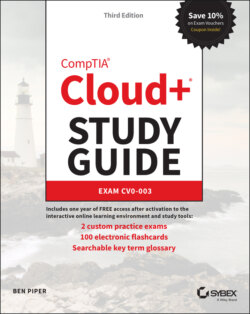| Exam Objective | Chapters |
| 4.1 Given a scenario, configure logging, monitoring, and alerting to maintain operational status.LoggingCollectorsSimple network management protocol (SNMP)SyslogAnalysisSeverity categorizationAuditsTypesAccess/authenticationSystemApplicationAutomationTrendingMonitoringBaselinesThresholdsTaggingLog scrubbingPerformance monitoringApplicationInfrastructure componentsResource utilizationAvailabilitySLA-defined uptime requirementsVerification of continuous monitoring activitiesService management tool integrationAlertingCommon messaging methodsEnable/disable alertsMaintenance modeAppropriate responsesPolicies for categorizing and communicating alerts | 1, 7, 8 |
| 4.2 Given a scenario, maintain efficient operation of a cloud environment.Confirm completion of backupsLife-cycle managementRoadmapsOld/current/new versionsUpgrading and migrating systemsDeprecations or end of lifeChange managementAsset managementConfiguration management database (CMDB)PatchingFeatures or enhancementsFixes for broken or critical infrastructure or applicationsScope of cloud elements to be patchedHypervisorsVMsVirtual appliancesNetworking componentsApplicationsStorage componentsFirmwareSoftwareOSPoliciesn-1RollbacksImpacts of process improvements on systemsUpgrade methodsRolling upgradesBlue-greenCanaryActive-passiveDevelopment/QA/production/DRDashboard and reportingTaggingCostsChargebacksShowbacksElasticity usageConnectivityLatencyCapacityIncidentsHealthOverall utilizationAvailability | 4, 5, 7, 8 |
| 4.3 Given a scenario, optimize cloud environments.Right-sizingAuto-scalingHorizontal scalingVertical scalingCloud burstingComputeCPUsGPUsMemoryContainersStorageTiersAdaptive optimizationIOPSCapacityDeduplicationCompressionNetworkBandwidthNetwork interface controllers (NICs)LatencySDNEdge computingCDNPlacementGeographicalCluster placementRedundancyColocationDevice drivers and firmwareGenericVendorOpen source | 1, 2, 7, 8 |
| 4.4 Given a scenario, apply proper automation and orchestration techniques.Infrastructure as codeInfrastructure components and their integrationContinuous integration/ continuous deployment (CI/CD)Version controlConfiguration managementPlaybookContainersAutomation activitiesRoutine operationsUpdatesScalingShutdownsRestartsCreate internal APIsSecure scriptingNo hardcoded passwordsUse of individual service accountsPassword vaultsKey-based authenticationOrchestration sequencing | 1, 2, 4, 5, 7 |
| 4.5 Given a scenario, perform appropriate backup and restore operations.Backup typesIncrementalDifferentialFullSynthetic fullSnapshotBackup objectsApplication-level backupFilesystem backupDatabase dumpsConfiguration filesBackup targetsTapeDiskObjectBackup and restore policiesRetentionSchedulesLocationSLAsRecovery time objective (RTO)Recovery point objective (RPO)Mean time to recovery (MTTR)3-2-1 ruleThree copies of dataTwo different mediaOne copy off siteRestoration methodsIn placeAlternate locationRestore filesSnapshot | 5 |
| 4.6 Given a scenario, perform disaster recovery tasks.FailoversFailbackRestore backupsReplicationNetwork configurationsOn-premises and cloud sitesHotWarmColdRequirementsRPORTOSLACorporate guidelinesDocumentationDR kitPlaybookNetwork diagramGeographical datacenter requirements | 6 |
